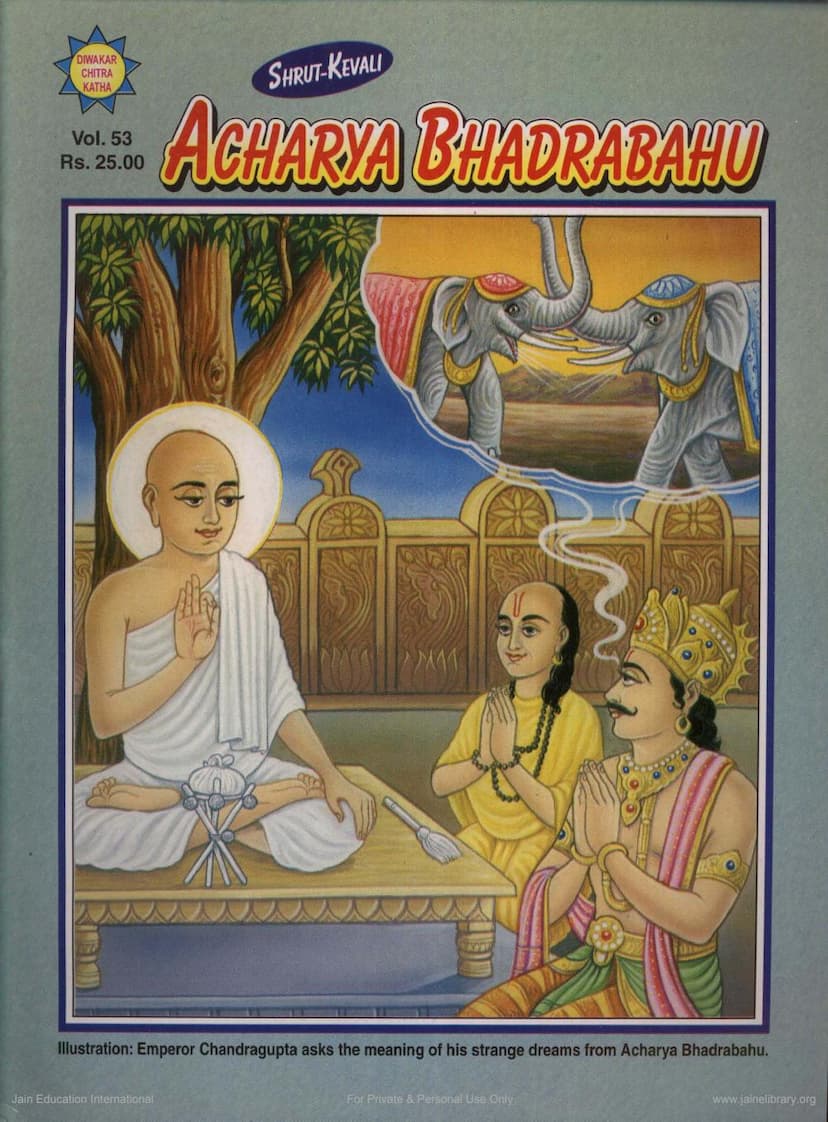Acharya Bhadrabahu Diwakar Chitrakatha 053
Added to library: September 1, 2025

Summary
This document is a "Chitrakatha" (illustrated story) focusing on Acharya Bhadrabahu, a prominent figure in Jain tradition, identified as the fifth Shrut-kevali.
Key Information about Acharya Bhadrabahu:
- Shrut-kevali: He possessed profound knowledge of all scriptures, particularly the fourteen Purvas (subtle canon), making him almost omniscient.
- Birth and Initiation: Born in Pratishthanapur in southern India in 376 BCE, he was initiated as a Jain ascetic by Acharya Yashobhadra Suri at the age of 45 (388 BCE).
- Successor to Acharya Yashobhadra: After the death of his guru's chief disciple, Acharya Sambhoot Vijaya, Bhadrabahu became the chief of the order. He was a teacher to many, including Sthulabhadra, who managed to learn only ten of the fourteen Purvas.
- Duality of Names and Stories: The text acknowledges confusion in Jain traditions due to multiple Acharyas named Bhadrabahu, leading to mixed-up incidents. The story presented is based on a popular oral tradition linking Acharya Bhadrabahu with the astrologer Varahamihir, despite a chronological gap.
- Spiritual Practice: He practiced Mahapran Dhyan in the mountain ranges of Nepal.
- Passing: He left his earthly body in 357 BCE.
The Narrative:
The story begins with the encounter between the scholarly Brahmin brothers, Bhadrabahu and Varahamihir, and Jain ascetics.
- Encounter with Acharya Yashobhadra: The brothers, initially proud of their knowledge, are drawn to a discourse by Acharya Yashobhadra Suri, a "Chaturdash Purvadhar" (scholar of the fourteen Purvas). Acharya Yashobhadra's discourse on the importance of combining knowledge with action (like a bird with two wings) resonates with Bhadrabahu, who realizes the inadequacy of knowledge alone.
- Initiation: Convinced, Bhadrabahu requests to be initiated. His younger brother, Varahamihir, initially hesitant, eventually joins him. Bhadrabahu quickly masters the Purvas, becoming a Shrut-kevali.
- Succession and Varahamihir's Envy: Upon Acharya Yashobhadra's passing, Sambhoot Vijaya and Bhadrabahu are appointed as joint Acharyas. Varahamihir, feeling overlooked and driven by ego, leaves the Jain order.
- Varahamihir's Fall: Varahamihir becomes an influential astrologer, claiming divine knowledge from the sun god. He gains favor with the king and becomes the State Priest.
- The King's Dreams and Prophecies: The king, Chandragupta Maurya, consults Acharya Bhadrabahu about his strange dreams. Acharya Bhadrabahu interprets these dreams, predicting a decline in religious knowledge, the rise of false gurus, droughts, social disruptions, and moral decay in the future (Kalikaal). Varahamihir, when asked by the king about the future of a newborn child, predicts a long and prosperous life. Acharya Bhadrabahu, however, accurately predicts the child's death within seven days due to a cat. The prediction comes true when a door-bolt, engraved with a cat's face, falls on the child. This event exposes Varahamihir's flawed knowledge, leading to his disgrace.
- Varahamihir's Revenge and Affliction: Humiliated, Varahamihir reincarnates as a Vaan-vyantar (a type of celestial being) and seeks revenge. He causes widespread suffering, including epidemics and destruction of Jain buildings.
- Overcoming the Affliction: Acharya Bhadrabahu meditates and identifies Varahamihir as the cause. He composes the powerful "Uvasaggaharam Stotra" (a hymn to Lord Parshvanatha) and uses mantraloaded water to alleviate the suffering. The Sangh's collective recitation of the stotra pacifies the affliction.
- Mahapran Dhyan and Drought: Acharya Bhadrabahu leaves for Nepal to undertake a twelve-year practice of Mahapran Dhyan. During his absence, a severe drought strikes eastern India, causing immense hardship and the death of many ascetics, threatening the lineage of Shrut Jnana.
- The Call to Return: With the tradition of Shrut Jnana in peril, the Sangh requests Acharya Bhadrabahu's return. He agrees to impart knowledge of the Purvas to deserving disciples while continuing his meditation.
- Sthulabhadra's Learning: Five hundred disciples, led by Sthulabhadra, are sent to Nepal. Despite the difficulty of the subject, Sthulabhadra diligently studies, eventually learning ten Purvas. Acharya Bhadrabahu, acknowledging Sthulabhadra's progress but also his pride, warns him about the vastness of the knowledge.
- Return to Pataliputra and Sthulabhadra's Ego: Acharya Bhadrabahu and Sthulabhadra return to Pataliputra. Sthulabhadra's sisters find him meditating in a cave, guarded by a lion (which Acharya Bhadrabahu later reveals to be Sthulabhadra himself, disguised). Acharya Bhadrabahu rebukes Sthulabhadra for his pride, stating that knowledge not properly assimilated is detrimental.
- Teaching the Remainder: On the Sangh's repeated requests, Acharya Bhadrabahu agrees to teach Sthulabhadra the text of the remaining four Purvas, emphasizing that knowledge should not be given to the undeserving.
- Chandragupta's Disengagement: The story concludes with Acharya Bhadrabahu preparing for his final days, passing the responsibility of the Sangh to Sthulabhadra. Chandragupta, deeply affected by the interpretation of his dreams, renounces his empire and embraces a spiritual path.
The book highlights Acharya Bhadrabahu's immense spiritual authority, his role in preserving Jain knowledge, his ability to overcome challenges posed by ego and malevolent forces, and the profound significance of his teachings for the spiritual well-being of individuals and the Jain order. It also emphasizes the importance of humility and the true integration of knowledge and conduct.